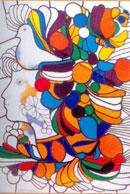A Motley Dance of Light
The ravaging flames that devoured the Santa Maria Cathedral in La Hispaniola (Dominican Republic) probably provided a heart-wrenching view. Before this architectural gem burned down to a crisp in 1586, Francis Drake walked off with everything he could laid his hands on, including the church windows. The larger-than-life corsair, however, was far from assuming that after his ransacking attack against the first city in the New World, the village was going to raise up from its ashes as dazzling as ever.
Now standing across from the Columbus Park, the Cathedral lords it with gothic and renaissance airs, two styles that go hand in hand in perfect harmony with the contemporary and renewed lines of its church windows, restored in 1990 by Rincon Mora, a well-known local artist.
THE POWER OF COLOR It's precisely that blend of optimism and joyfulness what gives this sunlight dance the colors that filter through church windows. It was Carlo Magnum who discovered that sensation in his quest for followers who could trust his power. At the time, the use of stained glasses was nothing but a manipulating resource in human spaces to simply make mighty men feel the strength of their own power.
In the era of Byzantine art, master glassmakers knew only the basics elements of their trade, yet they were strongly attracted to geometrical forms. In the early 11th century, they started using lead rods to piece together dozens of small stained glass fragments, portraying a variety of motifs and appraisals of the divine kingdom of the heavens.
However, as soon as the gothic elements popped up in the 1300s, these gaudy shades were splayed with flying colors in lots of church naves. As other periods in the history of the arts went by, church windows began little by little to conquer palaces, marketplaces and even some mansions.
Wrapping up this brief tour through the history of church windows, we cannot pass up the Art Nouveau, Liberty and Art Deco styles that stretched between 1890 and 1930. During that span of time, architectural irreverence was closely linked to the defying pictorial language of women, flowers and plants.
THE CARIBBEAN AGAINST THE LIGHT A magenta cross framed in a glass circle welcomes visitors to the main Anglican Protestant Church in Antigua & Barbuda. In the Church of the Valley Virgin on the Caribbean island of Margarita in Venezuela, a fisherman gazes up to the sky as he feels the descent of the worshipped holy woman. The former is a soberer case of ornamentation. The latter, though, makes viewers realize they're unmistakably in front of a typically tropical creation. A coconut tree jutting out on one side gives it away.
Despite visual differences, both church windows have a common denominator: the sun. And that's the distinctive feature that tells these church windows from the European peers. Even though conquistadors took to the sea to chance upon these shores, the most exquisite church windows found their ultimate representation in the realm of light that marks this permanently torrid region.
From the Cathedral of the Pure Conception in the central Cuban province of Cienfuegos and the Anglican Church of St. George in Montego Bay, in northeast Jamaica, all the way to the Cathedral of the Holy Trinity in Trinidad & Tobago and the Santa Martha Cathedral in Colombia's Cartagena de Indias, bright sunrays proudly beam against all things.
These church windows have been “blessed” by a natural phenomenon of electromagnetic radiation called light. However, this quasi-ornamental element was no longer exclusive to the religious temples.
Hotels, restaurants, mansions, doors and swing windows, either in Kingston or in Havana, now boast magnificent church windows stripped of all ecclesiastic elegance as they spruce up houses and residences.
FROM OLD-TIMED TO MODERN Houses in the Vedado area of the Cuban capital and in Old Havana affect church windows that deck out intimate human spaces near huge staircases. These domiciles get a daily bath of colorfulness every morning, some of them depicting the bodies of Greek goddesses and seducing nymphs.
A similar spectacle happens on a regular basis in the inner patios of solares, the common living quarters that abound in the old part of town, inviting passersby to stick in their heads and steal a long look. With their fan-shaped church windows usually decorating the upper doorframe, these solares are stylistically friendly when it comes to giving visitors a welcome salute.
Regardless of their capability to let sunlight through, their round shape laid out in four window panes (sometimes five), serve as perfect complements to the square form of the main gateways. Moreover, the screens that still divide rooms in many houses across the country speak volumes of the close-knit relationship between white wood and stained glasses. They came once to this land to stay for good and make no mistakes about it; they've been handed down from one generation to the next as venerated ornaments well taken care of.
Nonetheless, Cuban glass blowers now take on new creations from a different approach as they use painted glass instead of stained fragments to make church windows. It's commonplace to see them putting together piece after piece, as if they were working on a huge puzzle that will eventually make up the most whimsical shapes. Thus, their skilled hands make butterflies, roses, lilies and even tocororos, the emblematic national bird of Cuba.
The restoration process that has brought a considerable number of architectural landmarks in Old Havana back to life has made Rosa Maria de la Terga, the area's professional glassmaker, aware of the esthetic value of her work. Up to now, she has given lots of those stained glasses around town quite a new lease on life. A case in point is the Hostel del Frail, where white and violet hues put up defying triangular elements against the green squares and red circles. Or the House of Perfumes, where the eyes get kind of dizzy before so many glassy friezes that run down from the ceiling all the way to the floor.
All these comments simply boil down to the clear-cut assertion that church windows have mingled up with us in modern times. And they have done it with grandeur and elegance, without making the whole process sound like a blasphemy. After all, the sun is a hundred percent behind them, buffing them with its mighty brightness and dancing rays.




































































